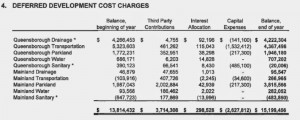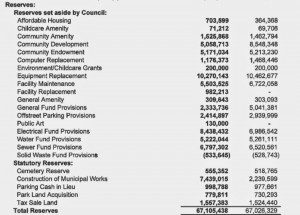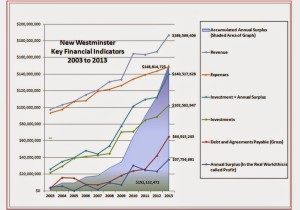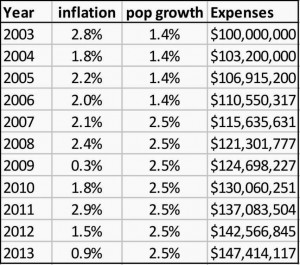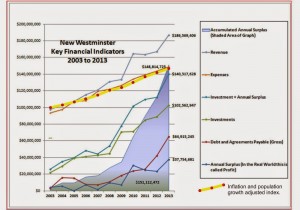The People might have noticed we didn’t have a Regular Council Meeting on February 16th. Instead, Council spend a bunch of time workshopping various topics as aCommittee of the Whole, both in open and closed session. You can watch the open portion online here.
This week, there was an interesting set of Delegations on the future of the Waterfront Parkade, but that is part of a bigger discussion I will cover in another post.
This week’s Regular Council meeting also included Opportunities to be Heard on two sign variance requests. Only the proponent of one came to speak on them, so Council moved ahead with the issuance of the permits:
DVP for 700 Sixth Street
The new Rexall Drugs want to add a couple of direction-finding signs to their free underground parking. Frankly, I was a little bothered that they had already installed these signs, and were asking for a variance now, but it appears there was a lack of understanding about the need for a variance, and the signs they are putting up will replace the ones they already have and will be less obtrusive (more neutral colour and non-branded), so I got past the oversight.
We received a bit of correspondence opposed to this variance from residential neighbours, but it appears they were mostly opposed to the existing lit signs on the buildings, which were approved without a variance back when the building was approved. I agree they are a little big and perhaps brighter than ideal, but it would be difficult for the City to go back and force the removal of a legally-installed sign. The new signs covered by this variance are not lit, so they at least won’t make the situation worse.
DVP for 1025 Columbia Street
We received no correspondence or delegations on this variance. Save-on-Foods want to add a sign to the side of their building so people on Royal Avenue are aware that they are driving by the back of a Save-on-Foods, which seems like a reasonable request.
So, on to the main meeting, which as always started with Recommendations from the Committee of the Whole from the afternoon:
Public Engagement Task Force
The Terms of Reference for the Mayor’s Public Engagement Task Force (of which I am a member) was expanded to put yet more public on it. There were many great applicants, and we had to work hard to winnow it down to what we feel are 6 unique voices who each bring something different to the table. I look forward to working with Jen, Chinu, Daniel, Nadine, Gabriella, and Nancy.
Financial Plan Update
Annual updates of the Financial Plan continue, and I suspect as the public process goes on, I will be writing several blog posts about it.
There were two votes Council took at the Committee of the Whole that were interesting (for a Mayor and Council that ran as a team this recent election) in that they both went down to 4-3 votes in Committee in the Whole. I think that is great sign that we are not being myopic as a Council, but are having meaningful discussions on important topics like the budget.
Council decided to save a bit of money by reducing the requested increase in Parks Labourer positions by 50%). I voted against this, as I felt Parks made an effective case for an increase seasonal staff to meet the demands that increasing green space in the City places on current crews. More people on Council agreed that the department should dig deeper for internal efficiencies to make this happen.
Another interesting discussion ensued around a request to allocate the “bonus money” we receive from digital sign revenues in accordance with the way we spend the baseline revenues. This is a bit complicated, but short version is that the City receives about $1,000,000 in base revenue from the digital signs that were installed last year, and Council made a policy decision when the signs were installed to split that base revenue into 50% for the fund to finance Canada Games Pool replacement, 40% for the Massey Theatre replacement project fund, and 10% into our Affordable Housing initiative fund. The signs are performing better than anticipated, so we expect about $400,000 in “bonus revenue” in 2015. Council has not established a policy on how these bonus revenues are used. It was proposed this year that we use that bonus money to offset some of the tax money we had already earmarked for the Canada Games Pool fund – which means we could take about $400,000 off of your annual tax bill and not short-change the capital planning for Canada Games Pool. Councillor McEvoy argued that not all of the bonus money should go to the CGP fund, but that 10% should go to our Affordable Housing reserve, as per council policy for the base funds. I disagreed, as did two of my council colleagues, but it takes 4 to win a vote.
During the last two Committees of the Whole, we have reviewed recommended changes to the Capital Plan that will move parts of the money into the 2016 budget. Short version here is that the City has both long-term capital plans (to schedule and finance the building and operation of City assets, from swimming pools to sidewalks to computers), and we have short-term capital needs. The money available to us (through your taxes, transfers from other governments, drawing from reserves, through cost-recovery, debt financing, etc.) for these items needs to be managed over a multi-year planning cycle. As a housekeeping measure mostly, the City moved many items from this fiscal year into the years when the funds are more likely to be spent. This move has no impact on your tax rate.
So our proposed tax increase for 2015 is currently pegged at 2.42%. Subject to change.
Mental Health Commission
It is no secret that most local governments are not satisfied with the lack of any kind of meaningful Mental Health strategy on the part of the Federal Government. The lack of leadership from senior governments means that local governments can either suffer the costs of having people with no access to care living on their streets and filling their police blotters, or local governments can step up and provide the missing programs to allow people with mental illness to live and integrate in our society. I’m new to Council so I can’t take credit, but I am proud of the work this City has done to take the latter approach. From working to find a variety of low-barrier housing options to bringing mental health training to our professional first responders so they can turn a potential conflict into an opportunity for someone to get assistance.
Amendment of Council Schedule
There are a couple of projects in the City that are looking like they will be coming to Council for a Public Hearing in April. If the volume of e-mails and letters Council is receiving on these projects is an indication, these will be well-attended public hearings. It is imperative that we allow everyone who wants to speak fair access to the process, but also have regular Council business to get done. Therefore Staff is suggestion we have two separate Public Hearing nights in April as opposed to only one. Hopefully this will allow us to hear more voices and still get home before midnight. Mark your calendars and clear some space on the PVRs, April 20 and 27th will both be Public Hearing nights.
Commercial Vehicle Amendment Bylaw 7742
Rolling right along on Opportunities to be Heard – Council previously agreed to move forward on a change in our Commercial Vehicle Bylaw to allow four more taxi licenses to be granted in the City. Changing the Bylaw requires a formal Opportunity to be Heard, which is scheduled for March 30, 2015 at our Regular Council Meeting. C’mon out and tell us what you think.
DP and DVP for 111 Wood Street
This is a 10-townhouse development on vacant land on South Dyke Road. The project has been though community consultation, Design Panel and the Advisory Planning Commission. Council moved to hold an Opportunity to be Heard on the required Zoning Bylaw change on March 23, 2015. C’mon out and tell us what you think.
Moody Park Spraypark
The plans to have a new spray park up and running this summer in Moody Park are, unfortunately, going to have to wait. The complicated job of re-jigging the underground services for the new waterfeatures is going to go into May, and that would mean the park would not be done until September or later, which would put the playground out of service for the busy summer season. Instead, Parks is going to delay the second phase of work until September, so Kids and family can enjoy the park in the summer, and have a spanking new park for spray season 2016.
Major Purchasing Transactions
The City’s Purchasing Policy requires staff to report out to Council on the major purchases over the previous fiscal quarter. This is that report. I’m happy to see many jobs were awarded slightly (but not too much) under budget. That means we are doing a pretty good job guessing estimating what capital projects cost, and that we are getting them done on budget.
ACTBiPed
I chair this committee, and am happy that ICBC volunteered to provide a liaison to the committee. So much of what we do at that committee has to do with pedestrian and cyclist safety, and ICBC is such an integral part of how transportation safety is planned in our region (and collects comprehensive stats on what works and what doesn’t), it will be valuable voice at that table.
Festival Grant Awards
The City has a staff committee who evaluate grant applications for festivals in the City. Staff are better able than Council to evaluate the viability of the proposed events, and to fairly evaluate the in-kind costs to the City of various events. Still, Council gets to decide if the recommendations of that Committee go forward. For the first time in 2015, these grant applications are separate from Community Partnership Grants, and the City has created a mechanism to “pre-approve” the events in up to two subsequent years. This will provide more certainty to the organizers, and allow them to secure longer-term sponsorship and event partnerships, which will hopefully result in bigger festivals in the upcoming years.
The City has $175,000 budgeted for festival grants, and we received requests for $273,844. Council agreed with the Committees recommendations and awarded $173,280 in total grants. I wish we could grant all of these events 100%. However, in the spirit of using many hands to make light work, I highly encourage you to contact the organizations and offer a little volunteer time. There is simply no better way to enjoy a Street Fest or a Parade than to actively take part in pulling it off! If you are going to be there anyway- why not volunteer a few hours to help out?
Council Delegation Procedure
In partial relation to the last item, our City Clerk (whose job it is to make sure our meetings are run fairly and in compliance with the applicable legislation) has made a couple of suggestions to make delegations work better.
The first is to restrict people from delegating on a topic once a Public Hearing for that topic has been scheduled. We can all think of previous occasions when a contentious project or decision is known to be upcoming, and for weeks leading up to that decision, people delegate to council speaking for or against it. If the project is coming to Public Hearing, it is vitally important that Council not pre-judge the process or argue for or against a project until the Public Hearing is completed. Therefore, if we allow delegations on a topic in the weeks leading up to the Public Hearing, Council cannot address the concerns of the delegate at that time, at risk of violating that impartiality.
This in no way limits your ability to speak with council in an open meeting on the topic, nor does it prevent you from calling, e-mailing, writing a letter, or bending a council member’s ear at the grocery store. It does mean, however, that if you want to delegate on a topic going to Public Hearing once the public hearing for the topic is scheduled, you need to do so at that Public Hearing instead of at a regular Council Meeting. It also assures when you do delegate on the topic, Council and Staff will have the correct information on hand to speak to your concerns.
The second change is to change the delegation form to allow a delegate to add their contact information right on the form, as often staff are requested to follow up with the delegate, and occasionally, that contact info is hard to get.
Review of City’s Towing Operation
The City operated tow trucks and a tow yard. Some people question (as with most things) whether it would make more sense for the City to contract that work out. In October (before I was on Council), Council asked staff to perform a financial assessment of Towing Services to determine if the City was indeed getting good value. Turns out the services provide better services at comparable rates to the major towing Service providers used by some other Cities. The service has (since 2011 at least) been revenue-neutral on towing operations, and has resulted in significant saving for the City in that the towing crews, when not actually towing things, have provided a variety of call-out services at no cost to the City, such as snow clearing, pump station or flood monitoring, parking meter maintenance, and assistance at special events emergencies that a towing company simply could and would not provide.
So we will be keeping our Towing Services folks around for a while longer.
Correspondence
Correspondence included two pieces requiring action:
1: An opportunity for the City to appoint someone to serve on the Metro Vancouver Agricultural Advisory Committee. We don’t have a lot of farms in New West , but we do have a farmer on council, and Councillor Puchmayr was our unanimous nomination.
2: The BC Seniors Games Committee is looking for host Cities for the years 2017, 2018 and 2019. Council asked staff to investigate the details regarding costs and commitments so Council can start the discussion if this is something New West is interested in doing.
Bylaws
Finally, we adopted Bylaw no. 7722, 2014. This is the final zoning amendment bylaw required to permit Bosa to start work on their development at 1000 Quayside Drive. This saw first and second reading on September 8 2014, went to public hearing on October 17 2014, and received third reading on the same night. Although I have not been part of the earlier discussions, I think this is a good development concept that has potential to benefit the Quayside area and especially the River Market, by boosting retail opportunities on that side of the tracks.
And that was a full day’s work.

